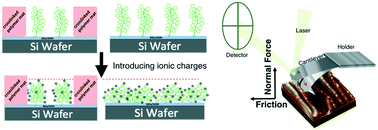Ionic conductivity and counterion condensation in nanoconfined polycation and polyanion brushes prepared from block copolymer templates†
Abstract
Microphase separated block copolymer electrolyte (BCE) systems are attractive candidates for electrochemical systems because the concentrated ionic groups in one block provide pathways for facile ion transport while the non-ionic block bestows mechanical integrity and suppresses excess water uptake. Numerous researchers have prepared and studied bulk BCEs as ion conductors, but the inherent complex nature and imprecise architecture of these materials make it difficult to extract definitive conclusions on how the macromolecular structure influences ion transport. In this work, the process of block copolymer lithography was demonstrated to create model nano-confined polymer electrolyte brushes that mimic lamellae structures found in bulk BCE membranes. Both nano-confined anion and cation conducting polymer brushes were prepared and excellent ionic conductivities (10−2 S cm−1 to 10−1 S cm−1) were obtained. Surprisingly, the nano-confined polycation and polyanion brushes displayed similar, or in some instances lower, in-plane electrical resistance values to the non-confined samples and shrinkage upon introduction of ionic charges. Using 2D force mapping AFM and atomistic molecular dynamics simulations, it was inferred that the nano-confined polymer electrolytes were less susceptible to counterion condensation explaining the unexpected changes in brush thickness after introduction of ionic moieties and the relatively low electrical resistance values. Overall, the block copolymer lithography platform presented in this work enables fabrication of precisely defined BCEs to systematically investigate how the microstructure and confinement governs counterion condensation and ion transport.

- This article is part of the themed collection: Charge Transporting Nanostructured Polymers for Electrochemical Systems


 Please wait while we load your content...
Please wait while we load your content...
